Update March 2018: Since writing this post, I have discovered many other strategies to help stay focused. I’ve compiled the strategies in a simple eBook called 70 ways to minimise distractions and focus better. You can download your free copy here.
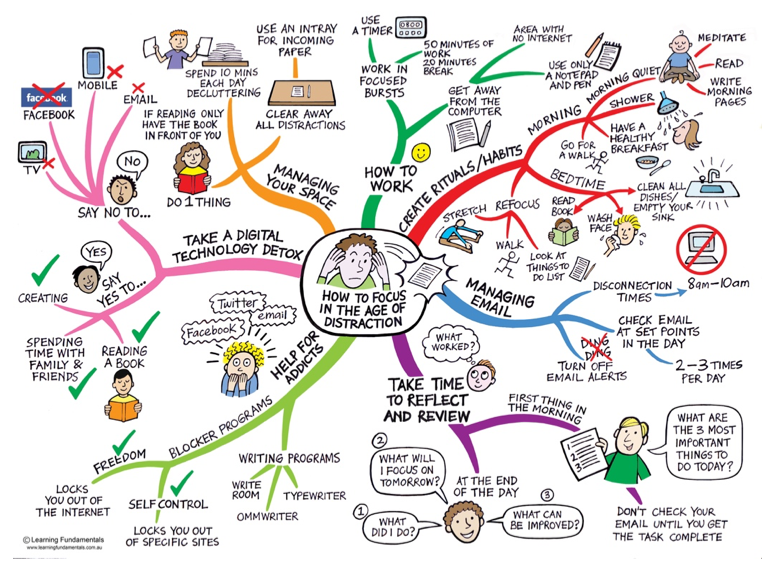
 If you’ve just logged into Facebook or your email for the 10th time today or find yourself thinking in Facebook statuses throughout the day, it may be time to read Leo Babauta’s eBook Focus: A simplicity manifesto in the age of distraction.
If you’ve just logged into Facebook or your email for the 10th time today or find yourself thinking in Facebook statuses throughout the day, it may be time to read Leo Babauta’s eBook Focus: A simplicity manifesto in the age of distraction.
This free eBook contains dozens of practical suggestions to help you enjoy life more, enhance your creativity and get things done.
If there ever was an equivalent of steroids for focus, this book is it – it’s a great tool to help anyone develop razor sharp focus and churn out quality work.
After reading this book, I made a number of changes that dramatically sharpened my focus. I have summarised a number of the strategies in the mind map below.
 Create Focus Rituals/Habits: Babauta defines a ritual as a set of actions you repeat habitually.
Create Focus Rituals/Habits: Babauta defines a ritual as a set of actions you repeat habitually.
He argues that rituals can help us to get into a focused mindset and suggests a number of rituals for:
For instance, my morning ritual involves having a shower, eating a bowl of healthy muesli with fresh fruit and 10 minutes of meditation. Nowadays, I resist the urge to check my email and Facebook in the morning.
 Managing Email: A lecturer once told me “You’ll get 10% more done in the day if you don’t check your email first thing in the morning”.
Managing Email: A lecturer once told me “You’ll get 10% more done in the day if you don’t check your email first thing in the morning”.
She was partly right. A more accurate assessment would have been 30%!
I’ve noticed that when I check my email first thing in the morning I feel slightly out of control for rest of the day. In reactive, agitated mode. Far from proactive, productive and peaceful.
Babauta states –
“Have a disconnect time each day. It’s like setting office hours if you’re a professor – you set the times that work best for you, and you can even let people know about these times.”
Set your office ‘disconnection’ hours and be strict with them (8am–10am is what works best for me). It’s highly likely that you’ll get the majority of work done for the day during these distraction free hours.
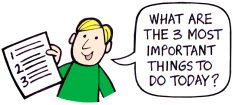 Take Time to Reflect and Review: Babauta recommends that we create a simplified list of the top three things we need to do in the day and then complete the most important task before checking email, Facebook, etc.
Take Time to Reflect and Review: Babauta recommends that we create a simplified list of the top three things we need to do in the day and then complete the most important task before checking email, Facebook, etc.
Sometimes it’s really tempting to want to check your email before completing the first task. But Babauta states:
“If you feel the urge to check your email or switch to another task, stop yourself. Breathe deeply. Re-focus yourself. Get back to the task at hand.”
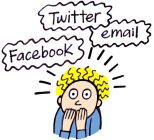 Help for Addicts: Don’t kid yourself, Facebook and email is highly addictive. Behavioural psychologist B.F Skinner’s experiments with rats in the skinner boxes illustrated just how addictive unpredictable rewards can be. The reality is Facebook is designed to be addictive. It’s full of unpredictable rewards.
Help for Addicts: Don’t kid yourself, Facebook and email is highly addictive. Behavioural psychologist B.F Skinner’s experiments with rats in the skinner boxes illustrated just how addictive unpredictable rewards can be. The reality is Facebook is designed to be addictive. It’s full of unpredictable rewards.
So let’s face it, some of us need help when it comes to controlling the number of times we log into these sites. That’s where Internet blocker programs come in – they either lock you out of the Internet entirely or certain sites that you specify.
When it comes to writing on the computer, some of us are easily distracted. Writing programs, such as Write Room, Write or Die and Typewriter, clear away all distractions and take up the whole screen on your computer. Some programs even make the sound of a typewriter as you write (but a word of warning, this gets kind of annoying after awhile!).
It’s important to note that these applications won’t miraculously solve your problem of getting easily distracted. They are just tools. They will help you sharpen your focus but only if you’re committed and disciplined enough to use them in the first place.
 Take a Digital Detox: We all need time away from the Internet, television, video games, etc. Time when we disconnect from these digital devices and immerse ourselves in other creative pursuits that will help us to grow. It’s also important for us to take time to reflect on our lives (when was the last time you sat back and thought, “Am I really doing what I want to be doing with my life?”)
Take a Digital Detox: We all need time away from the Internet, television, video games, etc. Time when we disconnect from these digital devices and immerse ourselves in other creative pursuits that will help us to grow. It’s also important for us to take time to reflect on our lives (when was the last time you sat back and thought, “Am I really doing what I want to be doing with my life?”)
Babauta suggests doing the following:
“Go on a mini cleanse. Start with something that’s not so scary: perhaps a day, or even half a day. Do this once a week. Later, as you get used to this, try a 2-3 day cleanse and maybe even work your way up to a week.”
 Managing Your Space: Remove 95% of all the posters and bits of paper stuck to your office wall. A clear wall means you have less stuff to be distracted by.
Managing Your Space: Remove 95% of all the posters and bits of paper stuck to your office wall. A clear wall means you have less stuff to be distracted by.
You may also want to consider investing in a pair of comfortable headphones. Headphones serve two functions – firstly, they block out the noise made by others so you have more attentional resources available. Secondly, they signal to others that you’re deep in thought and don’t want to be disturbed.
 How to Work: Work in focused bursts for 50 minutes (no distractions) and then take a 20 minute break. In your break get away from technological devices. Go for a walk, do some stretches, etc. Move your body in some way that feels good to you.
How to Work: Work in focused bursts for 50 minutes (no distractions) and then take a 20 minute break. In your break get away from technological devices. Go for a walk, do some stretches, etc. Move your body in some way that feels good to you.
When you work it can also help to get away from your computer and work with just a notepad and pen. Again, it’s most likely that you’ll feel the urge to want to go online when you do this for the first time. If this is the case, take a deep breath and refocus.
All in all, I really enjoyed reading Focus: A simplicity manifesto in the age of distraction. It was easy to read and written in a clear and focused way. Babauta provides a lot of valuable information and strategies that can easily be incorporated into one’s life.
Want to learn more strategies to help you focus in the age of distraction? Check out my free eBook 70 ways to minimise distractions and focus better.
Share This:

Before adopting any new technology, the Amish will carefully consider how the device or app could impact their values, community, and way of life.
In these times of rapid change, I believe this is a valuable practice for all of us.
I recently received an email from a company that had developed an AI mind-mapping tool.
The email included a special offer. If I blogged about this AI mind mapping tool, I’d receive a year’s free pro-subscription.
Look, I love free stuff. When I see the word ‘free’, something funny happens in my brain.
I come from a thrifty family who hate waste and excessive consumption. For as long as I can remember, we’ve always received free items from others. Old bikes, broken laptops, and fridges (you name it!): we’d take the stuff, fix it, and use it.
As a family friend used to joke, “If it’s too good to throw away, give it to the Genoveses!”
But as I looked at this offer of a free subscription to mind mapping software, the usual rush of dopamine I’d get when I saw the word ‘FREE’ just wasn’t happening.
I felt nervous and uneasy.
I took a closer look at the website. At first glance, the tool looked quite impressive. You could import text, PDFs, images, and books into it, and the tool would automatically generate a mind map for you within seconds.
The website claimed this was a tool “Empowering 100,000+ thinkers”. It said it could save me time. I could generate and seamlessly edit mind maps. All of this sounded good in theory.
So, why was I having such a strong negative reaction to this new AI tool?
I recently finished reading a book called The Extinction of Experience: Reclaiming Our Humanity in a Digital World.

In this book, author Christine Rosen argues that we are facing a human crisis caused by Big Tech. The widespread adoption of technologies, such as social media, dating apps, and smartphones, has fundamentally altered the human experience — and not for the better.
Interacting with screens all day long and living in virtual worlds that reward us for sharing our most private thoughts has diminished the human experience and left us feeling disconnected.
Rosen argues we run the risk of developing habits of mind and machine-like behaviours that lead us towards an impoverished experience of the world.
In one part of her book, Rosen discusses the decline of skills like handwriting. She states:
“Like species decline, skills decline gradually.”
This sentence made me stop in my tracks. It stood out to me. Why? Because I have felt some of my skills declining in recent years.
So, when I checked out this AI mind mapping tool, I put my Amish cap on and asked myself the following questions:
If I were new to the practice of mind mapping and had only just discovered mind mapping software, things might have been different. I would have had no awareness of what I was missing out on.
But I have been mind mapping by hand, with pen and paper, for over 20 years. I don’t use any fancy apps or software (I never have).
This has been a deliberate choice on my part to preserve and sustain a practice that helps me understand and learn new information in a highly effective way.
I worry that switching from pen and paper to keyboard, mouse, and computer will cause something fundamental to change (and be lost) about my current mind mapping experience and practice.
Before adopting any app or device, you need to get clear on what job you are hiring this piece of technology to do. I use mind mapping to learn and clarify my thinking. Could this mind mapping tool do this for me?
This mind mapping software could produce a mind map for me within seconds. As one student writes in a testimonial on the website:
“I post my own lecture notes to generate a very concentrated mind map for me. I don’t have to spend 3-6 hours writing my own mind maps, which I often can’t do very well.”
Another person leaves a five-star review, “No more messy brainstorming”.
However, all of this completely misses the point of mind mapping.
The process of mind mapping is just as important as the final, often messy, mind map.
When I mind map, I’m not concerned about creating a work of art or saving time (it takes as long as it takes to understand a topic). I want to take my time, settle into the process, and avoid feeling rushed. Mind mapping by hand allows me to do this.

Creating a mind map on a computer screen quickly and outsourcing the job to AI puts me in a speedy, turbocharged frame of mind, which is not conducive to deep learning.
Mind mapping is a practice that forces me to slow down.
This slowing down is super important because the world around me is sending me signals to speed up and go faster and faster! When I’m in turbocharge mode, I’m more likely to get distracted and feel overwhelmed.
I’m trying to resist this frantic pace because I want to do things thoroughly and at my own speed. Watching a mind map get created within seconds isn’t what I want or need. It shifts me into overdrive mode, which makes it much harder to learn.
Mind mapping by hand also allows me to think deeply about ideas and how they are connected. The only way I can see those connections and understand them is by reading through the information, thinking about how I would convey that information as a picture and in mind map form.
When you outsource the process to mind mapping software, you don’t get the same deep understanding as you would if you took the time to do it yourself by hand. It feels superficial. To me, it feels like the McDonald’s of Mind Mapping: fast, convenient, but ultimately, not particularly nourishing for my brain.
Using mind mapping software also bypasses something else that brings me joy and satisfaction: it feels really nice to work with my hands.
As Rosen says, “We have a human need to see, touch and make things with our hands”.
Making a mind map with your hands may not be quick, easy, or convenient, but it provides a very rewarding experience for your brain and soul. Personally, it makes me feel calm, grounded, and more connected to ideas, myself, and the world.
I don’t want to be ignorant or closed-minded. This is why I created a free account with this mind mapping AI tool and attempted to generate three mind maps.
The first mind map was on an article I’d read. The mind map focused on just a small section of the article (conspiracy theories). If I hadn’t read the entire article, I would have missed the important science on this topic.
The second mind map was on creating a meal plan for a trip away. Although the mind map provided some ideas, I was left feeling dissatisfied and uninspired. You can see my hand-drawn mind map on a meal plan, which I created for a family trip, compared to the AI-generated one below.
Which mind map do you prefer?


For the third and final mind map that I tried to create, I entered the following prompt:
“Create a mind map on the book ‘Die with Zero’ by Bill Perkins?”
I encountered this error message:
“System resources have been exhausted. Please try again later.”

Instead of feeling frustrated, I was grateful for this message as it highlighted another problem with using mind mapping software: when the tech goes down or power goes out, you are rendered helpless. It also reminded me of how energy-intensive AI is to run.
I went away and mind mapped this book by hand (I’d just finished reading it and had marked up several ideas). You can see the mind map I created below (it took me approximately 40 minutes to do).

I was curious to see if my mind map would resemble the one the mind mapping software generated. So the next day, I entered the same prompt again. Less than 3 seconds later, a mind map appeared on the screen (you can see it here). Was this a mind map on the same brilliant book I’d just read?
It seemed like AI slop.

I felt disconnected from the ideas. The spirit of the book just wasn’t there! I preferred my own mind map.
There is a freedom in mind mapping by hand, away from screens and without AI. The freedom comes not only from using your hands, brain, and creativity, but also from being able to focus on the task at hand.
It’s all too easy to get distracted when working on a computer. That’s why I have set up a dedicated space in my office, away from screens, where I do my mind mapping practice.
Mind mapping is a sacred practice for me. Doing it on a computer and outsourcing the process feels abstract and detached. I can see and feel what is being lost from the process.
Some tech enthusiasts may label me a “luddite”, but as Rosen says, “not every new thing is an improvement on the old”.
I say, stick with what works. Let’s not overcomplicate something that is simple but highly effective when it comes to learning. Put aside your fear of creating messy mind maps, step away from the screen, and enjoy the experience of making a mind map by hand.
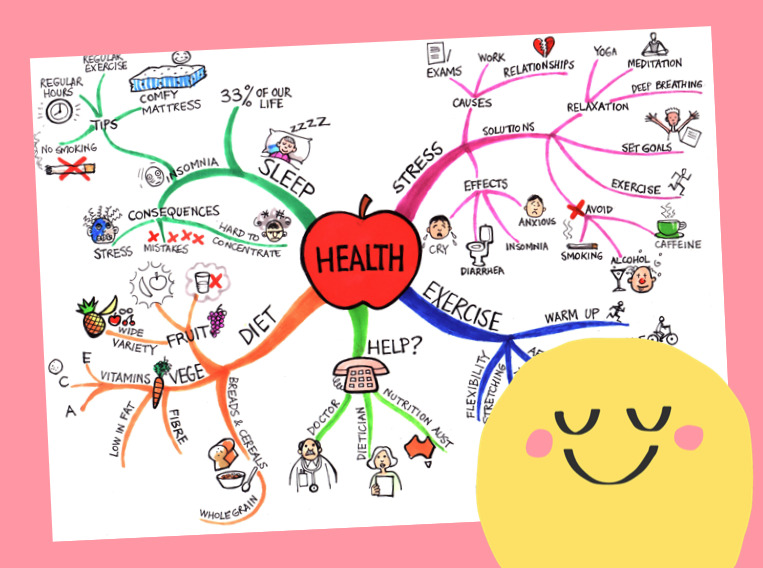
When you start using this strategy, it can feel clunky and awkward. It requires some mental effort to get going.
Why can it feel hard to start mind mapping?
Because it isn’t a habit (not yet, anyway). But once mind mapping becomes a habit, it can feel easy and deeply rewarding.
So, how do you get to that point where mind mapping feels easy? Even fun?
In this article, I will explore how you can create a habit of mind mapping. I’ll show you how to remove friction or pain points so it’s much easier to put pen to paper and absorb ideas.
Let’s start by looking at what gets in the way and stops many people from creating mind maps in the first place. I’ll also share some strategies you can use to overcome each of these barriers.

When you look at a mind map with all the pictures and different colours, it seems like something that would take a fair amount of time and effort to create.
If you’re comparing mind mapping to the time it takes to read your book passively, then yes, mind mapping will take more time. But you need to understand that reading your book passively is not an effective way to learn. In contrast, mind mapping is super effective.
People often fall into the trap of trying to make their mind maps look like works of art. Try lowering your standards and allowing yourself to make a mess when you mind map. This will speed up the process.
Another time trap is trying to mind map as you read and trying to mind map everything you read. I find it’s much faster to read and tab key ideas worth mind mapping later on. Once I’ve finished reading either the chapter or book, I then commence the mind mapping process. By this stage, I have a better understanding of the key ideas and what’s worth mind mapping.
Some people get hung up on the way their mind maps look. They can’t stand looking at messy pictures and scribbled words. If that’s you, perhaps you could take your drawing skills to the next level with some practice and sketch classes. But it’s not necessary.
Mind maps are not there to look pretty. They are there to help you learn. I am a big fan of badly drawn mind maps. If you look at my mind maps from university, they’re not works of art but they contain loads of important ideas. And that’s what matters most when it comes to learning.
Here’s a simple hack: invest in a set of nice, vibrant coloured pens. A bit of colour on the page will make your mind maps more visually appealing.

Mind mapping is straightforward. You draw a central image, curved lines, a few pictures, and write down key ideas. That’s it!
It’s not something you need to read a book about. You don’t need to enrol in a 10 week program to learn how to do this.
If you want some tips on how to mind map, check out my free Mind Mapper’s Toolkit. It’s a quick and easy read.
It’s important to realise that the first time you engage in any new behaviour, it will most likely feel strange and uncomfortable. You may feel a bit clumsy and awkward. You may have questions, “Am I doing this right?”. All of this is normal and to be expected.
Even something as simple as the pen you mind map with can make or break the mind mapping process.
You’ve probably noticed that some pens don’t feel pleasant to write or draw with. For instance, I’m not a fan of the popular Sharpie pen range. I don’t like the way these pens bleed through the page. And I really don’t like the way they smell.
These may seem like minor irritations and quirks, but trust me, they’re not. Your mind mapping experience will be diminished by a pen that doesn’t feel good in your hand or on the page. And any behaviour that feels unpleasant is much harder to sustain.
I’ve since ditched my Sharpie pens. I mind map with a uniball signo pen and non-toxic Tombow paintbrush pens. As far as coloured pens go, I won’t lie, these pens are pricey! But you can find them online for $25 cheaper than in Officeworks (a big stationery store in Australia).
What I love about these pens is that they are super easy to use, feel lovely to strike across the page, and they won’t leave you with a splitting headache from the ink smell.
Here are some things that have helped me to establish this habit in my life:
When is the best time for you to mind map? Where in your day can you easily slot in a 15 minute mind mapping session?
I like to mind map when I feel fresh and mentally alert (first thing in the morning).
Find an activity that you do every day without fail (e.g., having a shower, eating breakfast or dinner) and use that to prompt you to start a mind mapping session.
For instance, after I have completed my morning routine (workout, breakfast and shower), that’s my cue to sit down and start mind mapping.
Before you start your session, set yourself up with everything you need to mind map. I like doing this the night before my morning mind mapping sessions.
Before I go to bed, I lay out a sheet of A3 paper, my pens, and my timer. The book I am mind mapping is open on the page where I need to start working. The next day, all I need to do is sit down, start my timer, pick up a pen, and away I go!

What’s one thing that can slow down the mind mapping process?
For me, it’s digital distractions (e.g., text messages and notifications).
You probably already know the things that tend to derail you. Create a barrier between you and those things.
For example, my phone is the biggest distraction for me. How do I deal with this? Before I start mind mapping, I take my phone and place it away from my body in another room.
This signals to my brain that my phone is off-limits and it’s time to knuckle down and focus on my work.

Don’t wait until you feel pumped and inspired to create a mind map. Set a timer for 10-15 minutes and start mind mapping (regardless of how you feel).
If you miss a day, don’t beat yourself up. It’s no big deal. Just say to yourself, “Tomorrow is a new day. I will get back into mind mapping then”.

When the timer goes off at the end of your mind mapping session, say to yourself, “Good job!”. Do anything that makes you feel instantly good. I often clap my hands or do a fist pump.
According to Professor BJ Fogg, the secret to wiring in any new habit is to release a positive emotion within milliseconds of engaging in the new behaviour. When you release positive emotions, this releases dopamine in your brain. This makes it more likely that you’ll engage in this behaviour again.

I mentioned this before, but it’s important to repeat it: don’t go cheap with your mind mapping tools. Invest in good pens and paper. My favourite pens for mind mapping are uniball signo pens (0.7 tip) and Tombow paintbrush pens. Regarding paper, I love using Rhodia paper (it feels like your mind mapping on butter).
It may sound a little dramatic, but mind mapping changed my life. I used to read books and then feel frustrated that I couldn’t retain much information. But now, I have a strategy I can easily use to help me understand and remember complex ideas. This gives me confidence when it comes to learning new skills and information.
I encourage you to be playful with this strategy. Don’t get too hung up on how your drawings look. Your top priority is to leave perfectionism at the door and have some fun. Because when it comes to mind mapping, done is better than perfect.
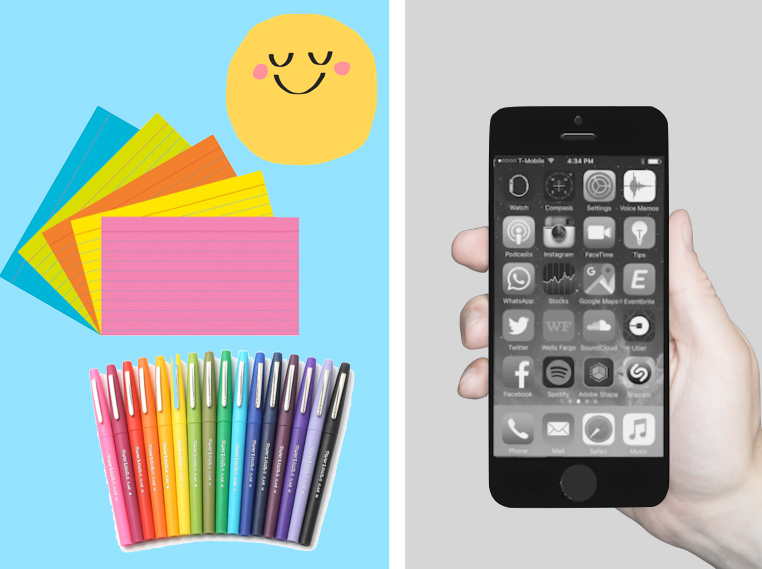
This is no accident. This is a deliberate design decision.
It’s the same reason why fast food logos are often warm reds, yellows, and orange tones. These colours jump out at us. They create a sense of excitement and urgency.
In his book Drunk Tank Pink, Dr Adam Alter argues colour is a hidden force in our lives that can shape the way we think, feel, and behave.
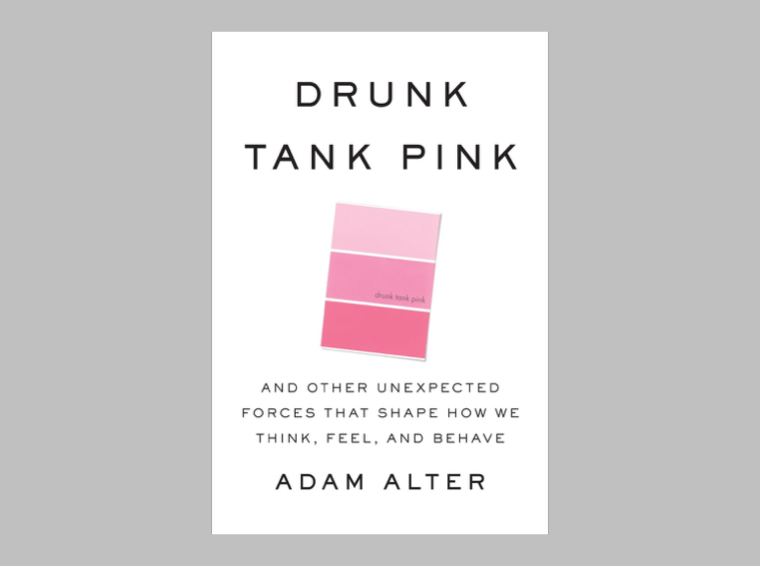
In this blog, I’m going to explore how you can use colour as a tool to help you study more effectively and keep your brain focused and engaged on the task at hand.
There is whole field of research dedicated to exploring the impact of different colours.
One fascinating study looked at the impact of a particular tone of pink (Baker-Miller Pink/Drunk Tank Pink) that appeared to sap people of their energy. Researcher Dr Alexander Schauss found staring at this shade of pink could lower people’s heart rate and pulse compared to staring at other colours.
A 7-month trial was conducted in which prison confinement cells were painted in this pink shade. According to Dr Schauss, when people were exposed for just 15 minutes to this pink colour in their prison cell, it made them more relaxed, less aggressive, and reduced the incidence of violent behaviour.
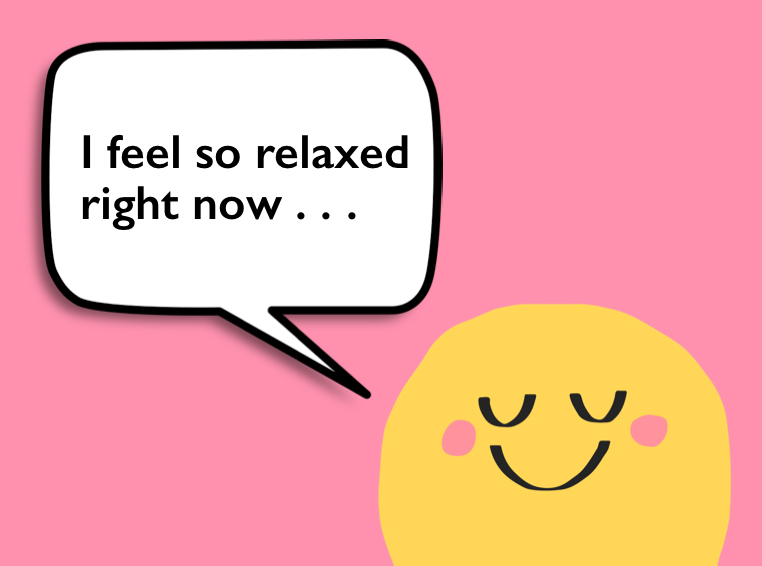
But before you race off to the hardware store to buy a tin of pink paint, you need to understand a few simple things about the psychology of colour.
The research suggests that colour can act as a powerful trigger. It can cue different emotions, thoughts, and behaviours. For instance, when you see a red Stop Sign or light, this captures your attention.
But how we react to colour also comes down to personal preference and particular contexts. Colour can have different meanings in different contexts (e.g., on Valentine’s Day red generally symbolises romance rather than “Danger! Look out!”).
The bottom line is this: when it comes to colour you need to experiment to see what works for you.
Colour can evoke particular states (e.g., a state of calm or alertness). It can also perk up your brain and transform a dry, boring subject into something that’s a little bit more novel and interesting for your brain.
Below I share 9 ways you can use colour to study and work more effectively.
There’s something about a brightly coloured post-it note that captures our attention. This is why I love using post-it notes to help focus my mind and stay on track.
On a post-it note, I create a list of no more than three things that I need to do. Once I’ve completed those tasks, I scrunch up the post-it and throw it in the bin. This action feels surprisingly satisfying! I’ll then grab a fresh post-it note (often in a different colour) to create a new list.
If I’m not sure how to get started with a task (e.g., Task: Write blog post on colour), I’ll grab another post-it note and I’ll scribble down the first tiny action I can take to kick-start the process (e.g., Tiny action: Open Word document).
If you have trouble finding your study materials for each subject and they all look the same or are scattered all over the house, you can use colour to make it easier for you to find what you need.
Try assigning a particular colour to a subject. This makes it easier to stay organised and identify your materials. At home, I assign a light blue to my exercise files and folders. When it’s time to plan my workout for the day, I look for my light blue files and folders.
A simple and cheap way to colour code your materials without investing in brand new stationery is to gather a collection of paint swatches from your local hardware store. You can repurpose these as labels by cutting them into smaller sections and sticking them on your files, notebooks, etc.
Testing yourself with flashcards is a highly effective way to study for a test and/or exam. You can create your own flashcard decks by purchasing index cards in a range of different colours.
Try assigning certain colours to different subjects. Alternatively, you can simply pick a colour you want to work with depending on how you feel.
There are no hard and fast rules. Feel free to mix up your flashcard colours to keep things fresh for your brain.
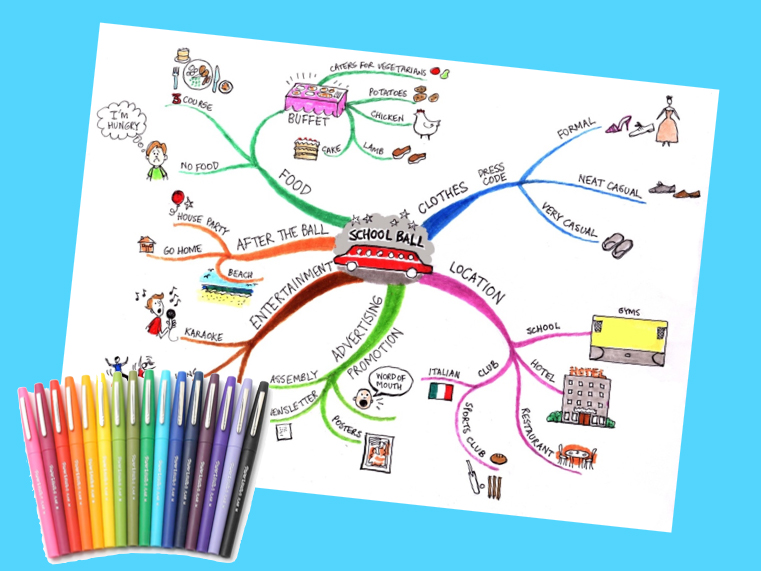
Creating a mind map on a topic is a simple way to combat study fatigue and inject a little colour and creativity into your study sessions.
Although using different coloured pens isn’t absolutely essential for mind mapping, it’s well worth doing. I use different colours to create the different branches on my mind maps.
I have dozens of colourful mind maps at home. Despite my lack of drawing skills, these mind maps look great and are fun to review primarily due to the different coloured branches.
It’s important that you feel good in your study environment. If you feel good in your study space, you’re more likely to sit down and study there.
I’ve decorated my workspace by putting up colourful posters, inspiring and funny pictures, and artwork on my walls.
If you don’t have access to artwork/posters, you can print out colourful pictures and quotes of things that make you feel good. The addition of a few indoor plants can also help to liven up your space as well as purify the air.
Fluorescent highlighters feel really good to use. It can feel both fun and satisfying to strike things off your to-do list. You can also use these pens to time block different tasks/events in your diary and draw your attention to important tasks that you need to do.
Word of warning: When it comes to studying for a test or exam, I don’t recommend highlighting your books and/or notes as a way to learn. I know it feels good but research shows it’s an ineffective way to learn.

Red pen is often associated with failure and criticism. This is why seeing a teacher’s comments scribbled in red pen can trigger negative emotions in many of us.
Generally, we don’t like reading comments written by others in red pen. It feels nasty! But it turns out if you use a red pen to correct your own work, this can help you to pick up more errors.
Dr Adam Alter discusses one study that looked at the difference between using a blue pen and a red pen to correct an essay. Students who used a blue pen picked up on average 19 errors. In contrast, students using a red pen picked up an average of 24 errors.
But using a red pen has its limitations! If you are trying to solve a problem or taking a test, using a red pen can backfire by activating ‘avoidance motivation’. This is a distracting state of mind that can impair a student’s ability to solve problems and increase stress levels.
As a rule of thumb, use a blue or black pen when solving problems and taking tests. But when you need to cast a more critical eye on your work (e.g., in the proofreading phase), switch to using a red pen.
A lot of us use our phones as an easy way to escape from the boredom and discomfort we experience when doing our work. The apps on our phones are like candy. They are designed to be highly addictive and hijack our attention.
This is where you can be strategic with how you use colour: you can make your phone look more like a tool (and less like a toy) by turning on greyscale mode.
Viewing your phone in greyscale is a completely different experience to using it in full-colour mode. As a year 8 student recently shared with me:
“When I made my phone greyscale, it made it really boring to use.”
Try it and see for yourself!
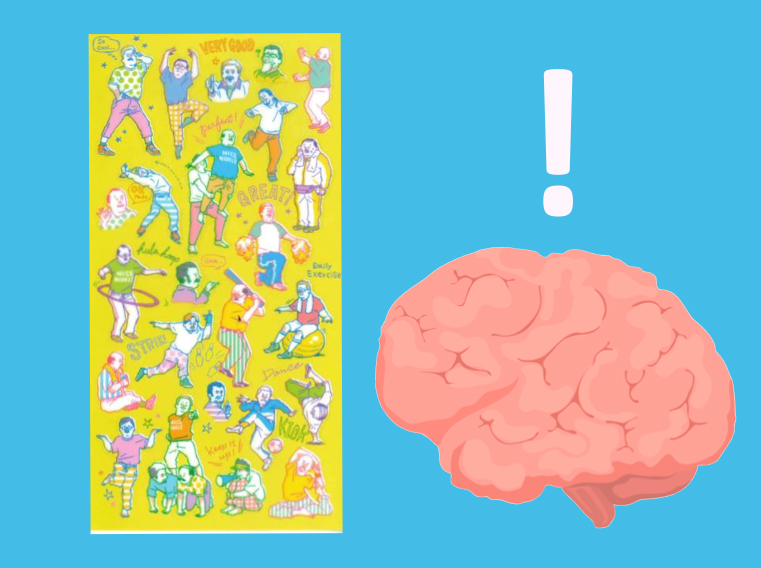
This strategy may seem juvenile. If it reminds you of being back in primary school and receiving gold stars, hear me out.
Too often we don’t stop to acknowledge and appreciate ourselves for accomplishing tasks. We finish one thing and we immediately shift our focus to the next task on our to-do list.
When you work this way, your work routine can quickly become soul destroying and your motivation can take a dive.
This is why every so often I pull out my fun stamps and colourful sheets of stickers. After completing a task, I pause and acknowledge what I’ve done by giving myself a stamp or a fun sticker. It’s a little celebration.
For some reason, my brain responds particularly well to quirky Japanese stickers featuring ogisan (Japanese grandfathers) exercising. We’re all different, so explore what stamps and stickers work for you.
Colours are lot of fun! Incorporating a little more colour into your studies and work life can take things to the next level and perk up your brain when it needs a little motivational boost.
But the colours that I like may not be the colours that you like. Your colour preferences may also vary from day to day. Notice the colours that make you feel good and have fun seeing how you can incorporate them into your study sessions.
Dr Jane Genovese delivers interactive and engaging study skills sessions for Australian secondary schools. She has worked with thousands of secondary students, parents, teachers and lifelong learners over the past 15 years.
Get FREE study and life strategies by signing up to Dr Jane’s newsletter:
© 2025 Learning Fundamentals